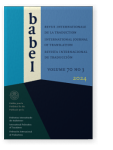Vol. 70:3 (2024) ► pp.334–356
Applying feminist translation strategies in audio description
On the negotiation of visual representations of non-normativity
Intersectional feminist translation provides visibility to the historically hidden or marginalized characters and narratives. This article interrogates the strategies we can apply to translate images into words, that is, to audio describe non-normative identities while adhering to the particularities of audiovisual productions. It poses the question of how to provide a feminist audio description that aligns with the creators’ intent. The objective of this study is to analyse the strategies applied to create a gender-conscious AD of a documentary on lesbophobia where ten women share their experiences as non-normative persons. They are defined by a series of intrinsic features such as race, gender expression or age and present a myriad of differences that have irremediably influenced their experience of lesbophobia and how society reads and identifies them. The visual contents in this documentary provide essential information that complements the understanding of the problem by people with visual impairment. This action research study analyses the challenges emerged during the AD production. It aims to emphasize the mediating power of AD professionals and how they influence the understanding of blind audiences.
Article outline
- 1.Introduction
- 2.Representation and translation
- 3.Audio description and gender
- 3.1Guidelines and recommendations
- 4.Object of study: The Lesbofobia documentary
- 5.Methodology
- 6.Case study
- 6.1Race and ethnicity
- 6.2Gender expression
- 6.3Disability
- 6.4Age
- 7.Conclusions
- Notes
-
References
